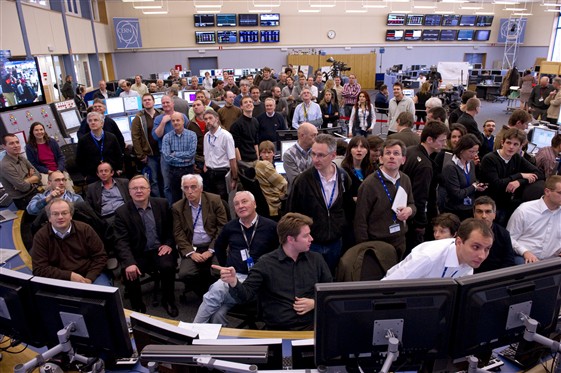Yes, we did it!
Nearly 20 years of hard work by hundreds of people have made this machine a dream come true. Today, the LHC has delivered its first high-energy collisions to the experiments. The new data will give us an unprecedented tool to understand the Universe we live in.
A few minutes ago in the CCC
Before the collisions, there was a mixture of excitement, expectation, fear and apprehension in the CERN Control Centre. Nobody had ever attempted to make two proton beams collide at 3.5 TeV before. Only Nature produces collisions like this routinely, in the processes that yield cosmic radiation, but in a way that makes it very difficult to extract meaningful data.

This morning in the CCC

At 13:06 in the CCC
"Today I feel very proud of my colleagues who have spent 15 hard years building the LHC. There have been many setbacks along the way and each one has been overcome with determination and commitment. It has been a privilege to have worked with them. We now know that the LHC is a beautiful machine. It behaves exactly as it was designed to do. There may be some consolidation needed in the future in order to push up to full energy but this is to be expected in a machine of such complexity. The team responsible for commissioning and running the machine has also shown great commitment and skill. Now let us get the experimental programme started and see what Nature has to tell us on the new energy frontier."
Lyn Evans, former LHC Project Leader
"Collisions of 3.5 TeV beams, 7 TeV total energy, at the LHC, is very good news for the particle physics community. I hope that steady running at good luminosity will be achieved and that we may learn what the cosmological 'dark matter' is."
Jack Steinberger, Nobel Prize in Physics 1988
"Humanity is about to look deeper inside matter than has ever been possible before. We have many theories of what we might find, but only experiments can tell us which, if any, are right. Why do particles weigh? What is the dark matter that fills the Universe? What was the origin of the matter in the Universe? The answers provided by the discoveries of the LHC will revolutionize our understanding how the Universe works, and how it has evolved."
John Ellis, CERN Theory Group
"Seeing the first collisions at 3.5 TeV per beam is one of the landmark events in the long history of the LHC. It's the result of more than 15 years' hard work on the machine and its injectors by many teams who have had to rise to many challenges. It shows that the different systems, which were tested separately beforehand, are all working well together. I don't know of any other scientific project involving so many components that have to function all at the same time. When you're standing in the Control Room you must never forget that what you see on the screen is not a giant video game but the product of a phenomenal quantity of equipment in the tunnel, designed and maintained by hundreds of people who've given their all to the project. Every time I watch a ramp-up on one of the screens in the CCC, I can't help thinking about all that equipment and the stored energies.
This milestone bodes well for the long physics run ahead of us. I'm proud and honoured to be involved in this scientific project."
Frederick Bordry, TE Department Leader
"Today we have seen collisions for the first time in the LHC at a beam energy of 3.5 TeV. This is the culmination of many years of work to build and install the machine and detectors, but also comes remarkably quickly after beginning the commissioning of the machine with beam. The speed with which the machine has been brought to the condition that we can declare stable colliding beams at high energy is a tribute to all the people that have worked so hard on its conception, design, construction, installation and commissioning.
We are progressing in the commissioning phase in a very systematic manner, preparing each phase carefully to understand the machine and the parameters of the beam at each stage before going on. This all takes time, but the quality of the machine and its instrumentation has allowed us to make very rapid progress. After today the commissioning will continue with a progressive increase in the performance of the machine as we increase the beam intensity and the focusing of the beams around the experiments. However, today also marks an important turning point. Today the LHC started the physics programme for which it was designed."
Paul Collier, BE Department Leader
"Giorgio Brianti first got me involved in the LHC in June 1988, so I've spent 22 years of my career on the project. Since 2001, when I became head of CERN's Magnets, Superconductors and Cryostats group, the LHC has been my life. What collisions at 7 TeV mean technically speaking is that we've succeeded in storing 2.5 gigajoules of magnetic energy in two thin 27 km pipes, that we're going to produce extremely hot collisions very close to the super cold temperature of 1.9 K, and that superconductivity is difficult but is allowing us to do unprecedented things. We hope that, like Galileo 400 years ago, we will see things that have never been seen before.
Today, on 30 March, I'm at the KEK Laboratory in Japan with the Director-General and other physicists to discuss Japan's participation in the future LHC upgrade. The collisions at 7 TeV centre of mass give us confidence that the LHC will reach its maximum energy (14 TeV) in two years' time and that we can already start preparing for the next step, the super LHC!"
Lucio Rossi, Head of the Magnets, Superconductors and Cryostats group

